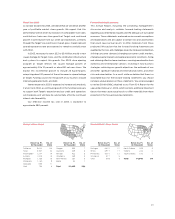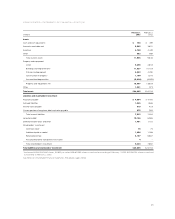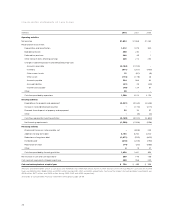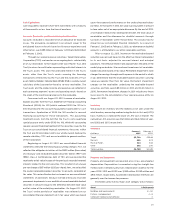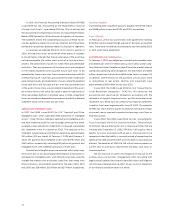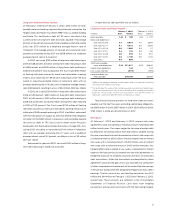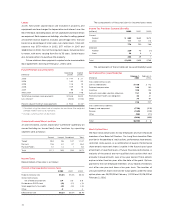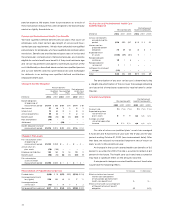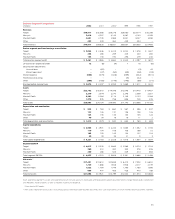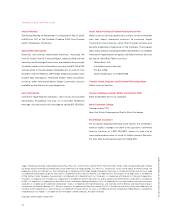Target 2002 Annual Report Download - page 32
Download and view the complete annual report
Please find page 32 of the 2002 Target annual report below. You can navigate through the pages in the report by either clicking on the pages listed below, or by using the keyword search tool below to find specific information within the annual report.
30
In 2001, the Financial Accounting Standards Board (FASB)
issued SFAS No. 144, “Accounting for the Impairment or Disposal
of Long-Lived Assets,” superseding SFAS No. 121 in its entirety and
the accounting and reporting provisions of Accounting Principles
Board (APB) Opinion No. 30 for disposals of segments of a business.
The statement retains the fundamental provisions of SFAS No. 121,
clarifies guidance related to asset classification and impairment
testing and incorporates guidance related to disposals of segments.
As required, we adopted SFAS No. 144 in the first quarter of
2002. All long-lived assets are reviewed when events or changes
in circumstances indicate that the carrying value of the asset may
not be recoverable. We review most assets at a store level basis,
which is the lowest level of assets for which there are identifiable
cash flows. The carrying amount of the store assets are compared
to the related expected undiscounted future cash flows to be
generated by those assets over the estimated remaining useful life
of the primary asset. Cash flows are projected for each store based
upon historical results and expectations. In cases where the expected
future cash flows and fair value are less than the carrying amount
of the assets, those stores are considered impaired and the assets
are written down to fair value. Fair value is based on appraisals or
other reasonable methods to estimate value. In 2002, impairment
losses are included in depreciation expense and resulted in a financial
statement impact of less than $.01 per share.
Goodwill and Intangible Assets
In 2001, the FASB issued SFAS No. 142, “Goodwill and Other
Intangible Assets,” which supersedes APB Opinion No. 17, “Intangible
Assets.” Under the new statement, goodwill and intangible assets
that have indefinite useful lives are no longer amortized but rather
reviewed at least annually for impairment. As required, we adopted
this statement in the first quarter of 2002. The adoption of this
statement reduced annual amortization expense by approximately
$10 million ($.01 per share). At February 1, 2003 and February 2,
2002, net goodwill and intangible assets were $376 million and
$250 million, respectively, including $155 million of goodwill and
intangible assets with indefinite useful lives in both years.
Goodwill and intangible assets are recorded within other long-
term assets at cost less accumulated amortization. Amortization is
computed on intangible assets with definite useful lives using the
straight-line method over estimated useful lives that range from
three to 15 years. Amortization expense for the years 2002, 2001
and 2000 was $29 million, $30 million and $27 million, respectively.
Accounts Payable
Outstanding drafts included in accounts payable were $1,125 million
and $958 million at year-end 2002 and 2001, respectively.
Lines of Credit
At February 1, 2003, two committed credit agreements totaling
$1.9 billion were in place through a group of 30 banks at specified
rates. There were no balances outstanding at any time during 2002
or 2001 under these agreements.
Commitments and Contingencies
At February 1, 2003, our obligations included notes payable, notes
and debentures of $11,017 million (discussed in detail under Long-
term Debt and Notes Payable on page 31) and the present value of
capital and operating lease obligations of $144 million and $924
million, respectively (discussed in detail under Leases on page 32).
In addition, commitments for the purchase, construction, lease
or remodeling of real estate, facilities and equipment were
approximately $509 million at year-end 2002.
In July 2001, the FASB issued SFAS No. 143, “Accounting for
Asset Retirement Obligations.” SFAS No. 143 addresses the
accounting and reporting for obligations associated with the
retirement of tangible long-lived assets and the associated asset
retirement cost. SFAS No. 143 is effective for financial statements
issued for fiscal years beginning after June 15, 2002. The adoption
of SFAS No. 143 in the first quarter of 2003 will not have an impact
on current year or previously reported net earnings, cash flows or
financial position.
In July 2002, the FASB issued SFAS No. 146, “Accounting for
Costs Associated with Exit or Disposal Activities.” The provisions
of SFAS No. 146 are effective for exit or disposal activities that are
initiated after December 31, 2002. SFAS No. 146 requires that a
liability for a cost associated with an exit or disposal activity be
recognized when the liability is incurred instead of recognizing the
liability at the date of commitment to an exit plan as was previously
allowed. The adoption of SFAS No. 146 will not have an impact on
current year or previously reported net earnings, cash flows or
financial position.
We are exposed to claims and litigation arising out of the
ordinary course of business. Management, after consulting with
legal counsel, believes the currently identified claims and litigation
will not have a material adverse effect on our results of operations
or our financial condition taken as a whole.





